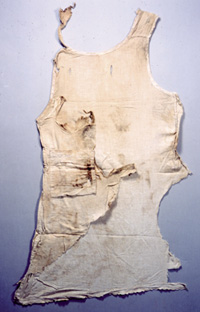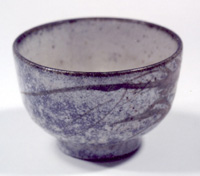Emotions Revealed |
| Of the materials donated during the period to the Hiroshima Peace Memorial Museum, we are providing a detailed introduction to a selected number of the materials collected in FY 2005. We invite you to read the comments and journal excerpts from the donors that express memories of the A-bombing and their current state of mind. |

|
Memories of That Day
These materials were donated by eyewitnesses. Sixty years later, we can still feel the unforgettable terror and suffering to which they testify.
That day--Monday, August 6, 1945--the sky was cloudless. As the midsummer sun mounted in the sky, the temperature soared. The yellow air-raid warning that sounded at 7:09 a.m. was cancelled at 7:31, and the city breathed a collective sigh of relief. Although it was August, schools rarely took holidays at that time. Students in the upper level of elementary school and older were working daily at factories or at building demolition sites. On this day, a great number of students and residents of neighboring towns and villages were mobilized for this work, and roughly 40,000 military personnel were in the city. Added to city residents, these additional people brought the total population in Hiroshima that day to approximately 350,000. That morning, the day started like any other. Then, at 8:15 a.m. a tremendous flash covered the entire city.
|
1
|
|
Satoru Arai, a fifth-grader at Oko Elementary School, was exposed at his building demolition worksite on the east end of Hijiyama Bridge. Badly burned on face, arms, and legs, he underwent treatment for years, plagued by keloid scars.
His father had written the characters for "Elem. 5, Satoru Arai" on Satoru's name badge on the left side of his shirt. They were burned into the cloth by the heat ray.
|
 |
|
 |
| 2 |
Donated by Satoru Arai (then, 10)
Approx. 1,700m from the hypocenter |
|
|
Dress
|
 |
Donated by Futaba Takase (then, 18)
Approx. 1,100m from the hypocenter
Futaba Takase evacuated on July 26 from Tokyo to a relative's home in Hiroshima with her mother, Setsuko and her younger sister Kasumi. The entire family was exposed at home in Ote-machi, 1,100 meters from the hypocenter. Burned on her feet, Setsuko pulled her two daughters out of the collapsed house. Futaba and Kasumi supported their mother from each side as they fled through the flames. Setsuko died of blood poisoning on September 1. Futaba and Kasumi suffered A-bomb-related disorders, but both recovered. The items displayed here are the dress Futaba was wearing that day.
|
 |
3 |
|
|
Chemise
Donated by Shinobu Horimoto (then, 19)
Approx. 1,700m from the hypocenter
Shinobu Horimoto was exposed at Osuga-cho, on her way from her home to the Hiroshima Railway Bureau, where she was assigned as a member of the Girls Volunteer Corps. She was trapped under a fallen building but extricated herself and fled, slapping out the flames in her clothing. She shed her ragged shirt and monpe trousers and walked to the mountains of Ushita, wearing only a chemise.
This chemise worn by Shinobu that day was handmade by her mother, Shitsuyo. The cuts were made to remove the chemise.
|
 |
|
 |
4 |
|
|
 |
Piece of glass, ticket, sewing iron
Donated by Shigeko Yano (then, 30)
Approx. 1,800m from the hypocenter
Shigeko Yano and her three children were exposed as they boarded a train bound for Kabe at Yokogawa Station. Though injured, they somehow made it to her family home in Toge. But Shigeko's mother-in-law, Ishi, was exposed and burned to death at home in Tenma-cho. Shigeko's husband, Nisaburo, who was exposed at Tokaichi, died on August 22. The piece of glass flew into Shigeko's monpe trousers pocket with the bomb explosion. The ticket was one of their train tickets. The sewing iron was a treasured possession that one of her children was carrying for her that day.
|
|
Bowl
Donated by Kayoko Miyake (then, 7)
Approx. 2,400m from the hypocenter
Kayoko Miyake, a second-grader at Ushita Elementary School, was exposed near her house at Ushita-machi. Kayoko, her grandmother Chise, Kayoko's younger sister, and Chise's older sister all fled to Ushita Elementary School. The girls' mother, Masae, who had been exposed and injured away from the house, managed to get to the school about a week later. The family was tearfully reunited.
The family dug this bowl from the ruins of their house and continued to use and treasure it long after the war.
|
 |
|
 |
8 |
|

